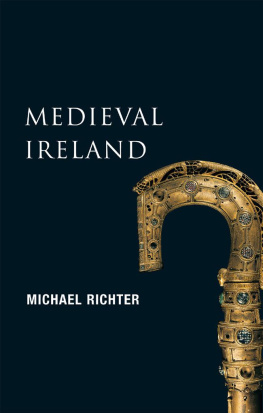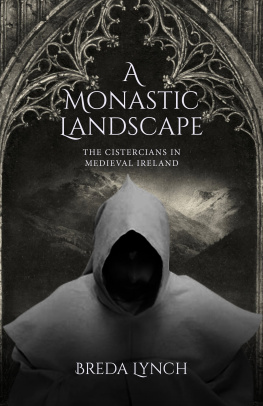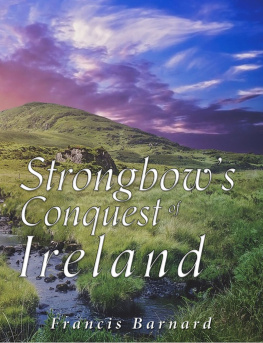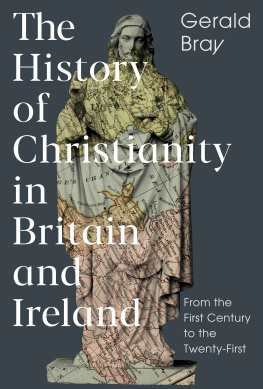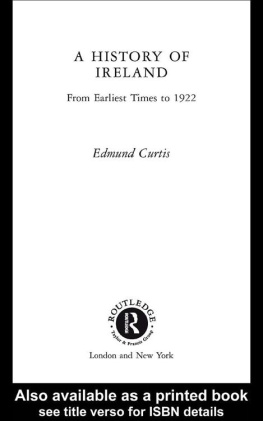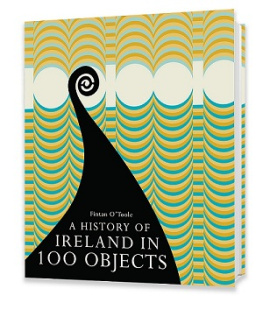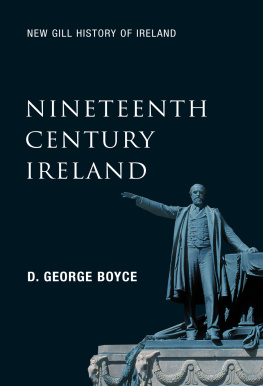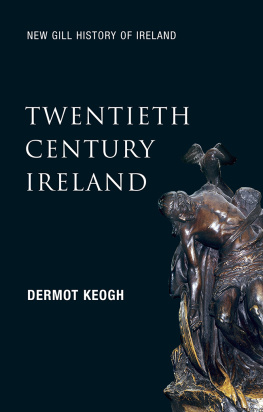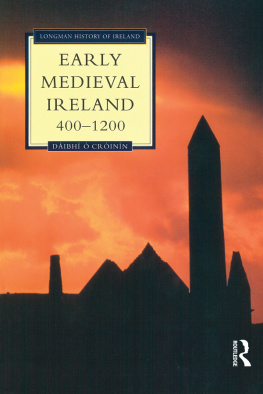New Gill History of Ireland
Medieval Ireland
The Enduring Tradition
REVISED EDITION
Michael Richter
with a foreword by
Prinsas N Chathin
Gill & Macmillan
To my friends in Ireland
Contents
Foreword
Prinsas N Chathin
This English translation of Irland im Mittelalter is a welcome addition to serious literature on the subject. Here we have a book which could not have been written with the same authority by either an Irishman or an Englishman.
A Continental historian who indulges in neither Iromania nor Irophobia, Professor Richter strikes a good balance which may sometimes ruffle insular feathers but which is fresh and free from prejudice and preconceptions.
He is singularly equipped to synthesise the complex tangle of early and medieval Ireland. His sojourn in Wales and experience of Welsh sources (particularly his work on Gerald of Wales), his familiarity with the writings of Bede, his work on Carolingian literacy and learning are all brought to bear on the Irish evidence. The twelve years which he spent in Ireland may not have made him Hibernicis ipsis Hiberniorem but he immersed himself in Irish scholarship with more dedication than many an Irishman.
The fruits of his participation in the Medieval Settlement Group, the Medieval Studies Seminar and in Early Irish and Hiberno-Latin studies at University College, Dublin, as well as in the International Colloquia on Early Ireland and Medieval Europe are clearly to be seen in the breadth of the material which Professor Richter sets before the reader.
Medieval Ireland: The Enduring Tradition will be read and enjoyed by many.
Preface to the first English edition
The starting-point of this book was a series of lectures which I gave at the University of Vienna in the winter of 1981/82. The keen interest of the students in Irish history and Irish culture prompted me to write a book on the subject. The Continental background may help to explain the title: medieval is understood to mean simply post-classical. On balance, it seems useful to retain this term for English and Irish readers.
The kind reception which the book obtained from Irish, English and Continental reviewers made me agree to a suggestion by F. X. Martin, OSA, head of the department in which I then taught medieval history, to have the book translated into English. I decided not to do the translation myself, knowing that I would be tempted to rewrite the book for the new audience. Although I have followed the translation process closely, the book is simply an English version of the German original. Naturally, I have corrected a few errors (a number of which were kindly pointed out to me by reviewers and readers); in two places, I have omitted brief references to things specifically German which would have meant little to English readers, and in one place, in Chapter 9, I have restructured a paragraph. The bibliography has also been updated and revised; it should be stressed that it remains only a basic guide.
It is a pleasure to give thanks to all those involved in the realisation of this book: to F. X. Martin for his initial suggestion and subsequent encouragement; to Maurice Keen for his decision to publish it in the series New Studies in Medieval History; to the late Denis Bethel, founder of that series, both friend and demanding colleague for a number of years; to the publisher, particularly to Ms VanessaCoachman, Vanessa Graham and to the translators. Unforeseen events in the course of the translation, particularly my move from Ireland to Germany, made it necessary to enlist a second translator. I should like to express my immense gratitude to Adrian Keogh for his help, skill and enthusiasm in translation and revision. I am also much indebted to those who have helped with suggestions and improvements, to Prinsas N Chathin, Jane Inglis and Imelda Gardiner.
In some respects, this book is the result of many discussions I had with my students and colleagues in Ireland. Ultimately, it became an alternative view of Irish history in the Middle Ages. As such, it is intended to enliven the discussion and to call into question what may appear at times to be established truths. History is what we make of it. I am very grateful for the many years I spent in Ireland and taught at University College, Dublin, and for all I learned there. Habeat sua fata libellus.
Konstanz, 17 March 1987
Preface to the second English edition
I am very happy to see this book coming out in a second edition. My thanks go to the publisher and staff in this matter. The German original of this book appeared in a revised edition in 1996. The revision consisted mainly in the correction of mistakes, and an updating of the bibliography, including my own work. These changes have been included in the present edition. Naturally, there have been numerous publications in the field since the book first appeared. However, generally speaking a book of this nature cannot be updated in the manner of changing spare parts in a dishwasher. In any case, the main theme of the bookcultural continuity in the face of political changeswill stand. The second edition of the German original includes a number of illustrations; unfortunately, it has not been feasible to include these in the present work. I would like to take this opportunity to refer to recent major works which, with their bibliographies, will help the reader:
Fergus Kelly, A Guide to Early Irish Law (Dublin, 1988). Irish Historic Towns Atlas vol. I, Kildare, Carrickfergus, Bandon, Kells, Mullingar, Athlone (Dublin, 1996). Prinsas N Chathin and Michael Richter (eds), Ireland and Europe in the early Middle Ages: Learning and Literature (Stuttgart, 1996). Fergus Kelly, Early Irish Farming (Dublin, 1997). Michael Richter, Ireland and her neighbours in the seventh century (Dublin and New York, 1999). Thomas M. Charles-Edwards, Early Christian Ireland (Cambridge, 2000). Prinsas N Chathin and Michael Richter (eds), Ireland and Europe in the early Middle Ages: Texts and Transmission (Dublin, 2002).
Konstanz, 23 November 2004
Maps
The Celts
T he history of Europe begins with the Greek civilisation which shaped the Mediterranean world in the last few centuries before Christ. Our information about the Hellenistic world, which was continued in many respects in the Roman Empire, comes just as much from contemporary written sources as it does from archaeological evidence. These sources provide a relatively complete picture which has, up to now, always been used in examining the past.
The culture of the Celts who at that time had a determining influence on Europe north of the Alps is, however, much less accessible. The Celts themselves did not possess any written culture; written accounts which have been handed down from pre-Christian centuries are sketchy and from outside sources. These accounts show particular signs of Greek and Roman moral concepts in their interpretation (interpretatio Romana). However, the substantial material culture of the Celts being evaluated by archaeologists does add to an overall picture which is an integral part of the prehistoric and early historic periods of European history.
During the last century before Christ, the remarkable Celtic culture was overshadowed on the mainland by the simultaneous expansion of the Germanic peoples of northern Europe and the Romans from the Mediterranean. The remains of this culture were best preserved in the extreme western areas, particularly in the British Isles. In the Middle Ages, the world of the Celts was regarded as finis terrae, a world wheremany strange phenomena persisted which aroused amazement and often defied understanding.
The Celtic peoples did not, of course, live completely isolated on the outer edges of the world; rather they contributed with their own dynamism to the shaping of Europe in various ways. For this reason alone it is important for anyone wishing to understand the complexity of European history to study the medieval Celtic peoples. This book is concerned with the Irish, the most important and influential of the Celtic peoples in the Middle Ages. We are relatively well informed about the Irish, since they developed a written culture at an earlier stage than most other European peoples. After those of the Greeks and Romans, theirs was the most significant European culture of the early Middle Ages.
Next page
